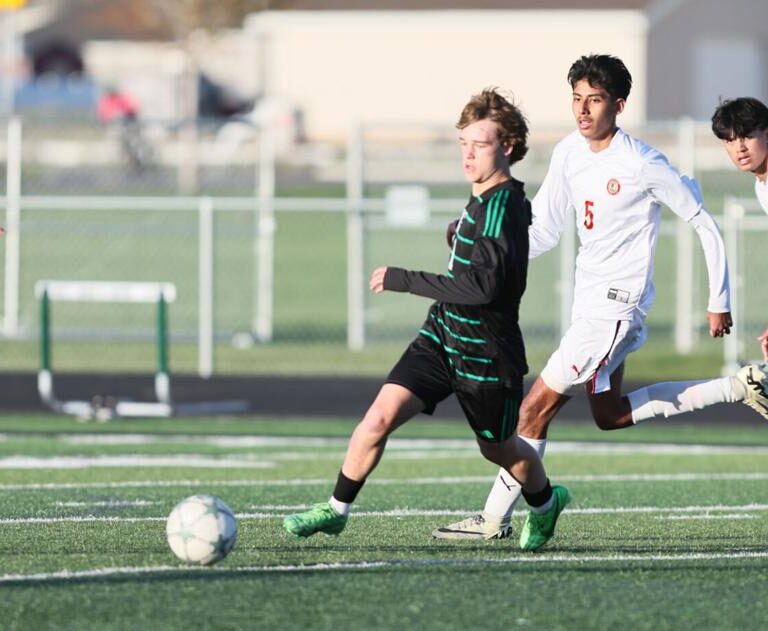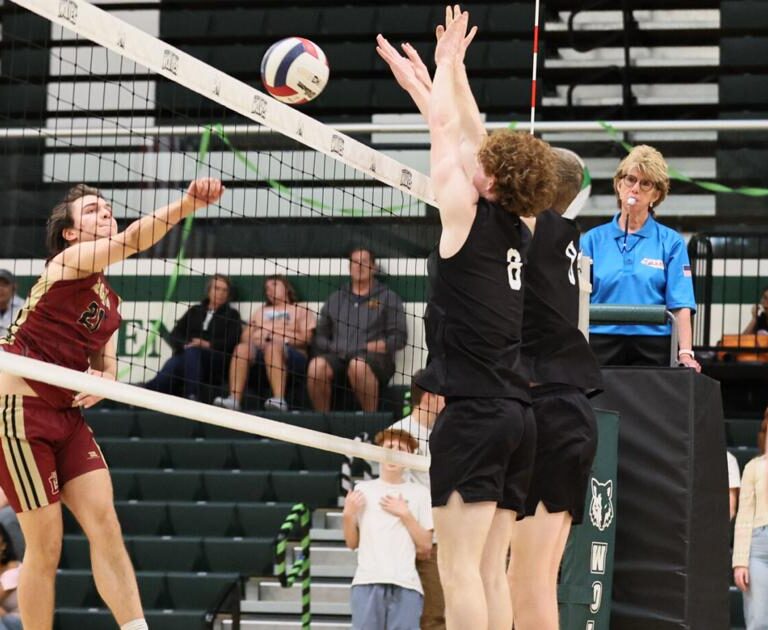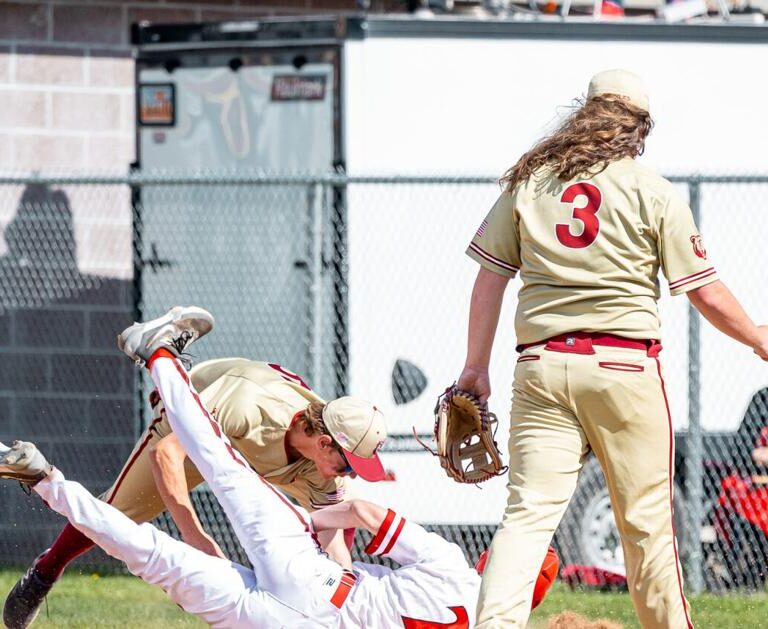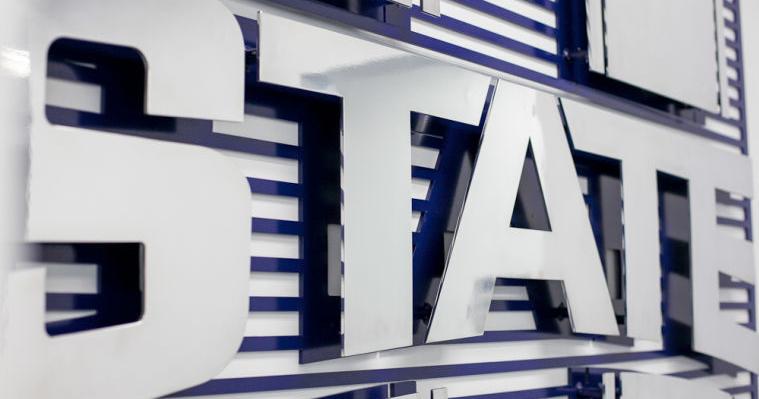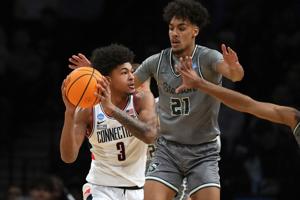
Utah State’s new head coach Jerrod Calhoun has added a second transfer of this offseason, Stetson forward/center and native of Belgium, Aubin Gateretse. It’s an addition that adds size (he stands 6-foot-11 and weighs 210 lbs) to the Aggies, something sorely needed in the wake of departures from Great Osobor, Kalifa Sakho and Max Agbonkpolo.
The rest of Utah State’s roster as currently formed consists of a lot of dynamic guards. Deyton Albury, Josh Uduje and Mason Falslev look like they’ll jointly carry a lot of the load for this team. Even Isaac Johnson is more of a perimeter big as a stretch five. There wasn’t much interior presence left on the team.
Gateretse’s addition balances the equation.
RELATED: — 2024 Utah State Men’s/Women’s Basketball Transfer and Roster Tracker
The most concise, though also extreme, display of what his impact can potentially be is his performance against Milwaukee back on Nov. 20. On that night, Gateretse scored a career-best 26 points on 12-of-13 shooting, grabbed 11 boards and set another career high with four blocked shots.
That highlight reel is most of what you should expect to see Gateretse do a lot of with Utah State:
- Score at the rim
- Rebound
- Block shots
That’s the short way to put it. It’s not sexy, nor is it going to fill out the box score a ton (aside from a few double-doubles), and he’s not going to be in line for a whole lot of conference recognition and awards.
It doesn’t mean he’s not going to play a crucial role on this team. The Belgian forward/center is a specialist, but he’s a specialist in areas for which USU currently needs to find production.
Starting with his scoring, Gateretse is a classic rim-running big who’s entire shot profile consists of attempts in the paint. It’s what helped him shoot 71.2 percent from the field this past season. That percentage would have led the nation but he didn’t meet the required 5.0 field goals made per game to qualify for the leaderboard (he averaged 4.7 makes per game).
Specifically at the rim, his field goal percentage was 75.1 percent, a straight-up elite, cream-of-the-crop number. Out of the nearly 1,000 players last year that attempted at least 100 shots at the rim, Gateretse was 12th. Among those who attempted as many of those shots at he did, Gateretse tied for second-best alongside Jayson Kent of Indiana State and only trailing the national Player of the Year, Zach Edey.
Something that should not go overlooked, though, is that Gateretse is more than just a rim finisher. He has great touch on a hook shot as well. Among players with as many hook shot attempts as Gateretse (49 per Synergy Sports data), he ranked 12th in field goal percentage last year. And that fact goes a long way in illustrating why he’s an overall great finisher at the rim. Gateretse simply has good touch on his close shot attempts. That ends up applying to all of his shots at the rim which end up having to come at unique angles and through tightly contested windows.
The rebounding and rim protection aspects of his game aren’t as elite as his rim finishing, but few will complain about the quality of either. Gateretse comfortably led Stetson in rebounding despite being a distant fourth in minutes per game on the team. His defensive rebound numbers aren’t anything particularly special but his offensive rebounding numbers are. Gateretse was one of 49 players last year to grab at least 100 offensive boards and was one of just nine to eclipse that mark while playing less than 900 minutes. That offensive rebounding talent is something Calhoun knows how to appreciate. Of his seven Youngstown State teams, all featured a player that averaged at least 2.7 offensive rebounds per game with five having a player that matched or exceeded Gateretse’s 2023-24 average of 3.0.
As for the defense, the shot-blocking is solid as he averaged 1.5 per game. He’s not going to be a force as an interior defender but it will certainly be an upgrade over last year where the Aggies little rim protection and even less true rim deterrence. Gateretse will be providing some of both. He should also be a capable post defender, something the Aggies are losing with Osobor on his way out.
The one area of concern on defense is fouling. Gateretse averaged 3.2 fouls per game, committing at least four fouls in half of his appearances this year. With the competition he’ll be up against only getting bigger and stronger on average, he’ll need to be more disciplined so he can stay on the court.
How the Aggies end up using Gateretse offensively will be an interesting case study. At Stetson, he benefitted quite a bit from a very good passing guard, Stephan Swenson (if his name is vaguely familiar, it’s because he transferred this spring and the Aggies were reportedly among his final three choices before he committed to UC Santa Barbara). Swenson averaged 5.8 assists per game, with a lot of his passes (and assists) going to Gateretse. A lot of those were lobs to the big man under the basket or well-placed entry passes for easy looks at the rim.
As good as Albury or Falslev are, they’re likely not going to provide the same kind of passing ability Swenson did, and thus create easy point for Gateretse. Neither has really been given that chance (Albury’s Queens teams hardly ran pick-and-roll actions with their bigs and Falslev’s role had him defer most of that kind of play to Darius Brown) but it’s a skill that takes time to develop so it’s unlikely to be present at this point. But there’s more than one way to gash teams in ball-screen offense.
Combining Gateretse’s screen-setting and the dynamic slashing ability of Albury, Falslev and Uduje has the very high chance of forcing a lot of teams to switch on ball screens. No one wants to have any of those players getting downhill toward the basket. So teams will switch, trying to hedge the guard and keep them from driving the paint. Well, now teams have just allowed the 6-foot-11 Gateretse who shoots 75 percent on shots near the rim and 53 percent on hook shots to be matched up in the post with a guard.
Here’s an example of that in action. Stetson runs a high ball screen, gets the switch it wants with Gateretse matched up on Queens’ point guard — coincidently the very same Deyton Albury who now plays for the Aggies — and it’s just not a contest. A quick swing pass makes the entry pass a walk in the park and the ensuing hook shot is just as easy.
The fact Gateretse finishes so well around the rim is very underrated for these mismatch scenarios. We’ve seen in the past Aggie centers (not going to name names, but there’ve been a couple in the last three years) that weren’t able to take advantage of mis-matches nearly as well despite having the same physical advantages as Gateretse.
This situation will work in the opposite direction too, with mismatches for Albury and Falslev against opposing bigs. Basically zero Mountain West bigmen are going to be able to keep up with Utah State’s guards and this will have coaches losing sleep over how to stop this very basic action.
The next most interesting case study with this addition is how will he and Johnson co-exist? Johnson has a lot of potential as an inside-outside offensive force, one that Calhoun should be loathe to limit. A first thought would be to play both Johnson and Gateretse at the same time, but that may not be all that viable. Coaches are often incredibly hesitant to play multiple 7-footers at the same time. Calhoun had that chance last year with the 7-foot-3 Gabe Dynes and 7-foot-even Imanuel Zorgvol, but neither played together throughout the year despite both seeing the floor consistently.
Johnson’s ability to hit the 3-pointer and play from the perimeter a bit more than a typical 7-footer alters things a bit. Looking across the college landscape there were cases of teams pairing tall shooters with their other bigs to have a twin-tower lineup that could still space the floor. There were six teams in college basketball that consistently put this kind duo on the floor: Utah, BYU, Alabama, LSU, Stetson and Coastal Carolina. It’s rare, but only as rare as tall shooters are (there were only 29 players 6-foot-11 or taller last year that shot at least 30 percent on 3-pointers with a minimum of 30 attempts)
Coincidently enough, three of those cases hit fairly close to Utah State. Two of its in-state rivals, Utah and BYU, started a floor-spacing twin-tower lineup for large stretches of the season — Utah had Branden Carlson and Lawson Levering with BYU going with Noah Waterman and Aly Khalifa — and Gateretse himself was part of that same kind of duo last year with his Stetson teammate Treyton Thompson. The Utah and BYU pairings were also two of the most successful cases with Carlson/Levering having the second-best plus/minus of any duo on the Utes and Waterman/Khalifa being the best frontcourt duo for the Cougars in terms of plus/minus.
The hope would certainly be that the Aggies can avoid the failures of the Gateretse/Thompson pairing. Stetson began the year with Gateretse/Thompson starting alongside each other but that lasted only nine games as it quickly became apparent that it wasn’t working too well. The starting five that featured the two bigs was the worst five-man lineup on the team according to EvanMiya data. After the ninth game with those starters, the Hatters adjusted the lineup to move Thompson to the bench and stagger his minutes with Gateretse.
The key for a Gateretse/Johnson lineup to work is going to be how they work defensively against smaller lineups. Danny Sprinkle didn’t trust Johnson for a second to effectively defend five-out lineups, but development from Johnson and a new defensive scheme may make that point moot. Assuming Gateretse and Johnson can handle guard-heavy lineups — a very common sight for college basketball — they’ll wreak havoc on the other end.
Even if the Calhoun opts not to start Johnson and Gateretse alongside each other for one reason or another, the fact remains that the Aggies now have more versatility in the frontcourt. If Calhoun wants more rebounding an physicality inside, he can get that from Gateretse or he can opt for the offensive impact of Johnson. Having options like that allow for coaches to be more creative.


